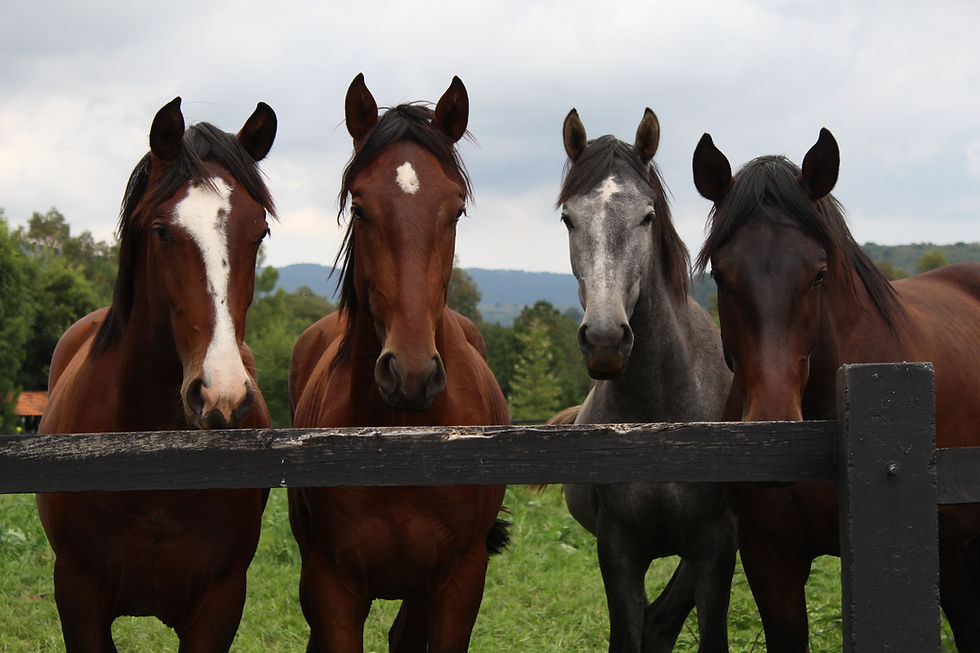How To Safely Move Around a Horse
- Britain

- Sep 2, 2022
- 4 min read

When it comes to horses, it‘s extremely important that we approach, interact and communicate with the horses around us in a safe manner. Not only is it important for us, but for the horses as it creates more trust and elevates their feelings of comfort.
It is imperative that we as humans are clear about our intentions and give horses consistency when working with them in order to preserve and maintain a bond of trust, which in turn as shown to reduce safety accidents. Whether you are just starting out and learning how to handle a horse for the first time, enjoy leaning over the fence watching or you have been working with horses for years, it's always good to follow these general guidelines. Here are a few ways to safely work around a horse.
Pay Attention!! In my opinion this is the most important, make sure that you are always aware of what's going on around you and how the horse you are working with is responding to you. Whether you are catching, saddling up or riding you should always have an understanding of what's going on around you.
A horses ears can tell you a lot of how how they are feeling.

If they pin their ears, they are telling
you they are scared or very upset, maybe even a little of both (Nellist, 2017).
When a horses ears are pinned they are more likely to cause you arm by biting, striking or kicking.

If a horse has their ears forward, they are attentive and in a relaxed state, they are listening and paying attention to you (Griffin, 2019).
When a horses ears are forward they are far less likely to act aggressively towards you and more accommodating/willing to be approached.
Protect your feet. Making sure you are wearing proper foot wear for the occasion is key. It is recommended to wear hard-toed shoes to avoid serious injury if stepped on accidentally (Blocksdorf, 2019). I always wear closed-toed shoes and recommend people avoid any footwear that has thin material or poor coverage of their foot such as flip-flops or sandals.
Approach a horse calmly. When you are calm and collected in tone and movement (aka walking), horses feel more comfortable and are less likely to spook or shy away because of fear. if You are being unpredictable with your movements and making lots of loud noises a horse is more likely to react in a negative fashion.


Always make sure they know where you are. Whether you speak calmly to the horse so that they can hear where you are or you always keep a hand on them, it's important that you keep telling them where you are.
Don't stand directly behind or directly in front of them. Horses have blind spots because of how their eyes are positioned. They cannot see directly in front of them or directly behind them, if you are in those areas they are more likely to get nervous and react in a negative fashion (Bickel, 2021 and Forsberg Meyer, 2019). They may kick out or strike out of fear and create an unsafe environment. They may even accidentally step on you because they can't tell you are there. The safest place to stand is beside the horse when working them (Blocksdorf, 2019).

Never loop your hand in the lead rope. Wrapping the excess rope around your hand can be extremely dangerous. If a horse gets frightened and pulls or takes off, your hand can get caught and severe injury could be inflected.
Do not cross to the other side by going under their neck. Taking the time to go around their neck instead of under can be the difference between a fun pleasant experience and a trip to the hospital. By going under their neck, you leave yourself open to an injury to the face from their front legs and/or from their mouth/head (McIntyre, 2011).
Feed with a flat hand. If you are hand feeding, make sure you do so with the treat laying on a flat palm, horses can accidentally nip or mistake your fingers for yummy carrots and pellets (Forsberg Meyer, 2019). It would be a better option to feed them with a bucket or bowl to avoid this entirely (Blocksdorf, 2019).

If something doesn't feel right it's wrong. That little voice in your head or that feeling in your stomach that makes you second guess yourself is usually right about telling your something is off. Sometimes there are feelings that cannot be expressed nor do they have a "reason" behind them; however, when you are attuned to your surroundings, you can often pick up on signs that there is a threat to your safety (McIntyre, 2011).
References
This information was cited using the following format: The Veterinary Journal
Bickel, B., 2021. Safe horse handling [WWW Document]. Penn State Extension. URL https://extension.psu.edu/safe-horse-handling (accessed 8.22.22).
Blocksdorf, K., 2019. Learn 11 tips for working safely with horses [WWW Document]. The Spruce Pets. URL https://www.thesprucepets.com/working-safely-with-horses-1885951 (accessed 8.22.22).
Forsberg Meyer, J., 2019. The 14 *essential* safety rules to follow around horses [WWW Document]. Horse and Rider. URL https://horseandrider.com/western-horse-life/essential-safety-rules-to-follow/ (accessed 8.22.22).
Griffin, A., 2019. Horse body language [WWW Document]. Extension Horses. URL https://horses.extension.org/horse-body-language/#Ears_Forward (accessed 8.22.22).
McIntyre, S., 2011. Horse Condition , in: Advanced Equine Massage Therapy Manual . pp. 4-6.
Nellist, J., 2017. My mare pins her ears when approached. what can I do to put her in a better mood?: Equimed - horse health matters [WWW Document]. EquiMed. URL https://equimed.com/health-centers/behavior/articles/my-mare-pins-her-ears-when-approached-what-can-i-do-to-put-her-in-a-better-mood (accessed 8.22.22).



Comments